Snack food company Utz Brands (NYSE:UTZ) reported results in line with analysts' expectations in Q1 CY2024, with revenue down 1.4% year on year to $346.5 million. It made a non-GAAP profit of $0.14 per share, improving from its profit of $0.11 per share in the same quarter last year.
Utz (UTZ) Q1 CY2024 Highlights:
- Revenue: $346.5 million vs analyst estimates of $346.8 million (small miss)
- Adjusted EBITDA: $43.4 million vs analyst estimates of $42.9 million (1.2% beat)
- EPS (non-GAAP): $0.14 vs analyst estimates of $0.13 (10.5% beat)
- Full year guidance maintained for organic sales and adjusted EBITDA, raised for EPS (due to tax and interest, though, rather than fundamentals)
- Gross Margin (GAAP): 34.5%, up from 29.7% in the same quarter last year
- Free Cash Flow was -$22.7 million, down from $17.49 million in the previous quarter
- Organic Revenue was up 1.5% year on year
- Sales Volumes were up 1.1% year on year
- Market Capitalization: $1.48 billion
Tracing its roots back to 1921 when Bill and Salie Utz began making potato chips in their kitchen, Utz Brands (NYSE:UTZ) offers salty snacks such as potato chips, tortilla chips, pretzels, cheese snacks, and ready-to-eat popcorn, among others.
In the century-plus after its founding, the company has grown through organic expansion of its portfolio as well as major acquisitions. Notable deals include the 2016 purchase of Golden Flake and the acquisition of Conagra Snacks in 2020.
Today, Utz goes to market with the Utz, Zapp’s, Golden Flake, Boulder Canyon, and other brand names. The company differentiates itself from other snack manufacturers by committing to use real ingredients and avoiding artificial preservatives.
It’s hard to pinpoint the core Utz customer because its product portfolio is so broad. If you don’t like chips, maybe you like pretzels. If pretzels aren’t your thing, there’s popcorn or cheese snacks. Suffice to say, though, that the core customer is likely someone who does the grocery shopping for his or her household and values proven brands.
The company’s products add convenience to everyday life, and they are also convenient to find. Ubiquitous retailers such as supermarkets, mass merchants, drug stores, and specialty stores sell Utz products.
Shelf-Stable Food
As America industrialized and moved away from an agricultural economy, people faced more demands on their time. Packaged foods emerged as a solution offering convenience to the evolving American family, whether it be canned goods or snacks. Today, Americans seek brands that are high in quality, reliable, and reasonably priced. Furthermore, there's a growing emphasis on health-conscious and sustainable food options. Packaged food stocks are considered resilient investments. People always need to eat, so these companies can enjoy consistent demand as long as they stay on top of changing consumer preferences. The industry spans from multinational corporations to smaller specialized firms and is subject to food safety and labeling regulations.
Competitors in salty snacks include PepsiCo (NASDAQ:PEP), Nestle (SWX:NESN), and Mondelez (NASDAQ:MDLZ).Sales Growth
Utz is a small consumer staples company, which sometimes brings disadvantages compared to larger competitors benefitting from better brand awareness and economies of scale.
As you can see below, the company's annualized revenue growth rate of 12.5% over the last three years was solid despite consumers buying less of its products. We'll explore what this means in the "Volume Growth" section.
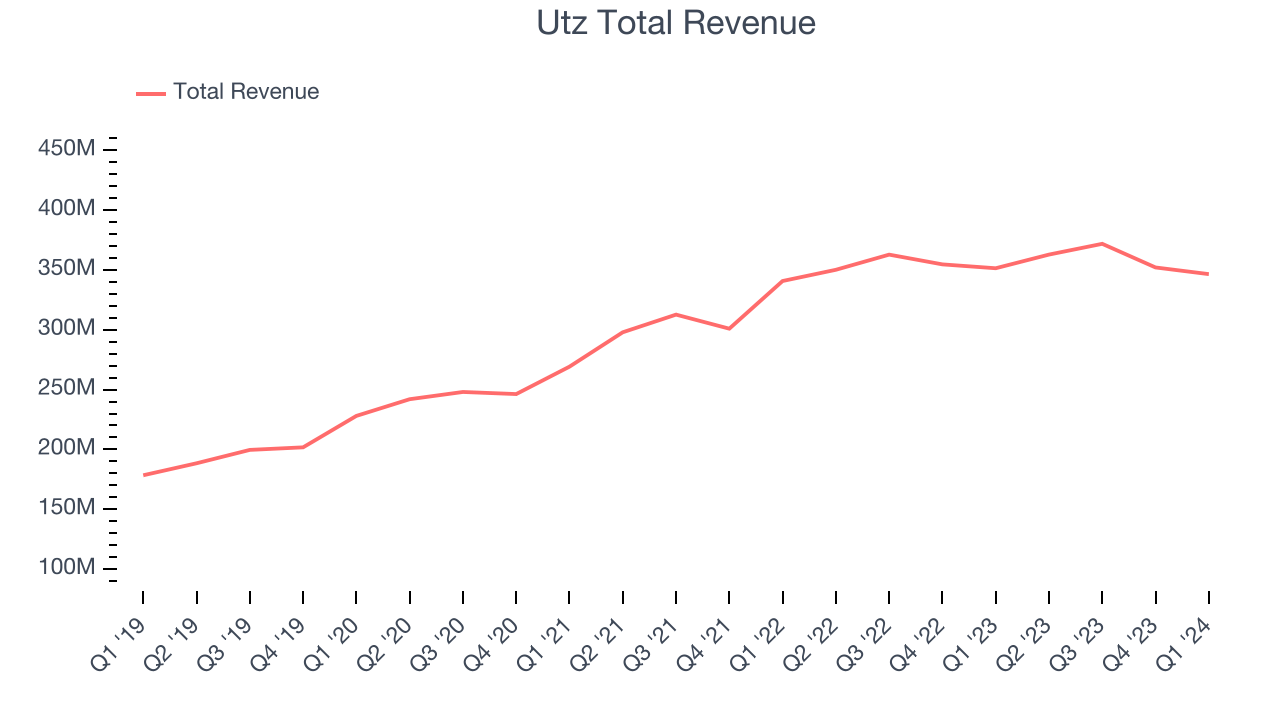
This quarter, Utz missed Wall Street's estimates and reported a rather uninspiring 1.4% year-on-year revenue decline, generating $346.5 million in revenue. Looking ahead, Wall Street expects sales to grow 1.3% over the next 12 months, an acceleration from this quarter.
Volume Growth
Revenue growth can be broken down into changes in price and volume (the number of units sold). While both are important, volume is the lifeblood of a successful staples business as there’s a ceiling to what consumers will pay for everyday goods; they can always trade down to non-branded products if the branded versions are too expensive.
To analyze whether Utz generated its growth from changes in price or volume, we can compare its volume growth to its organic revenue growth, which excludes non-fundamental impacts on company financials like mergers and currency fluctuations.
Over the last two years, Utz's average quarterly sales volumes have shrunk by 1.2%. This decrease isn't ideal as the quantity demanded for consumer staples products is typically stable. Luckily, Utz was able to offset fewer customers purchasing its products by charging higher prices, enabling it to generate 6.8% average organic revenue growth. We hope the company can grow its volumes soon, however, as consistent price increases (on top of inflation) aren't sustainable over the long term unless the business is really really special.
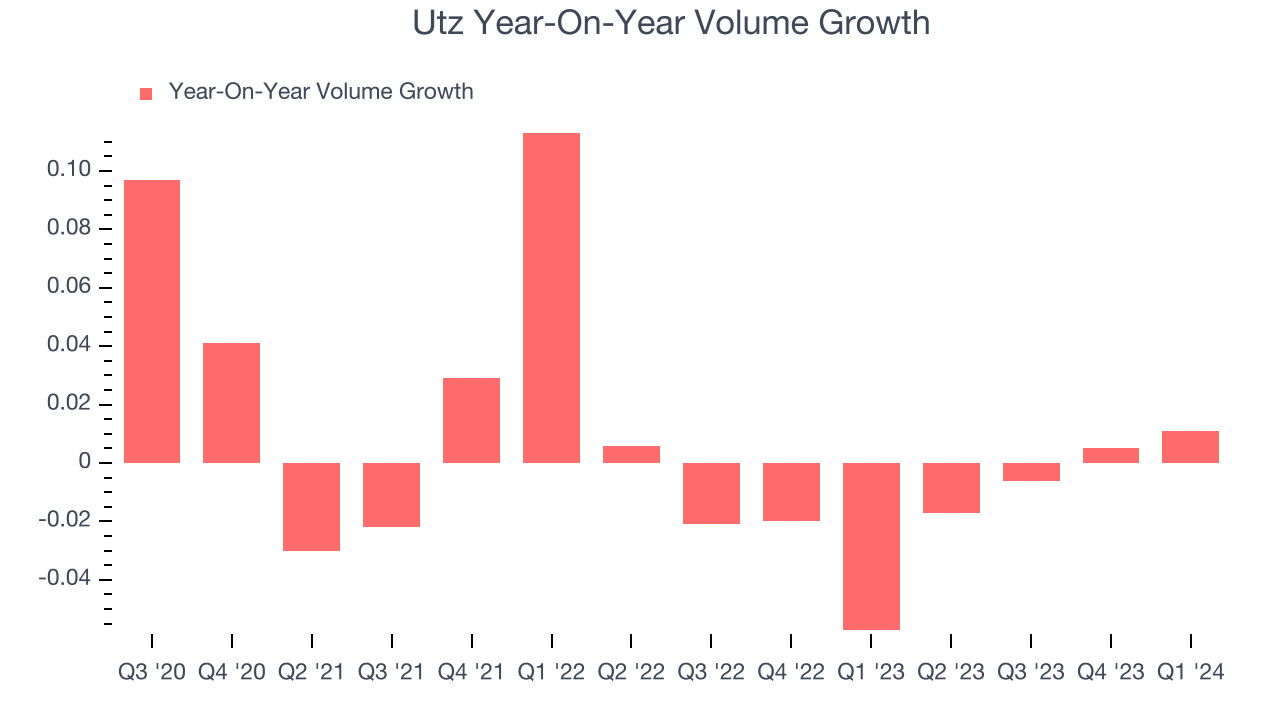
In Utz's Q1 2024, sales volumes jumped 1.1% year on year. This result was a well-appreciated turnaround from the 5.7% year-on-year decline it posted 12 months ago, showing the company is heading in the right direction.
Gross Margin & Pricing Power
All else equal, we prefer higher gross margins. They make it easier to generate more operating profits and indicate that a company commands pricing power by offering more differentiated products.
This quarter, Utz's gross profit margin was 34.5%, up 4.8 percentage points year on year. That means for every $1 in revenue, $0.65 went towards paying for raw materials, production of goods, and distribution expenses.
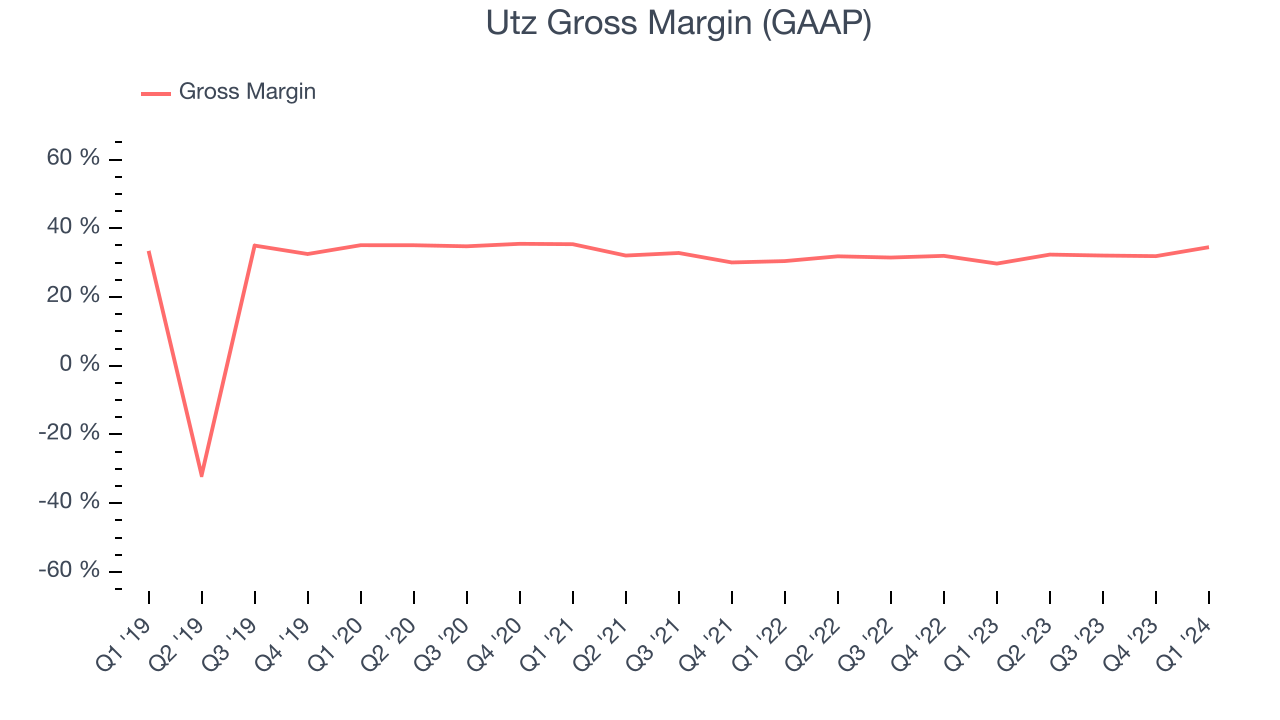
Utz's unit economics are higher than the typical consumer staples company, giving it the flexibility to invest in areas such as marketing and talent to reach more consumers. As you can see above, it's averaged a decent 32% gross margin over the last eight quarters. Its margin has also been trending up over the last 12 months, averaging 4.8% year-on-year increases each quarter. If this trend continues, it could suggest a less competitive environment where the company has better pricing power and more favorable input costs (such as raw materials).
Operating Margin
Operating margin is an important measure of profitability accounting for key expenses such as marketing and advertising, IT systems, wages, and other administrative costs.
In Q1, Utz generated an operating profit margin of 2.8%, up 3.4 percentage points year on year. This increase was encouraging, and we can infer Utz had stronger pricing power and lower raw materials/transportation costs because its gross margin expanded more than its operating margin.
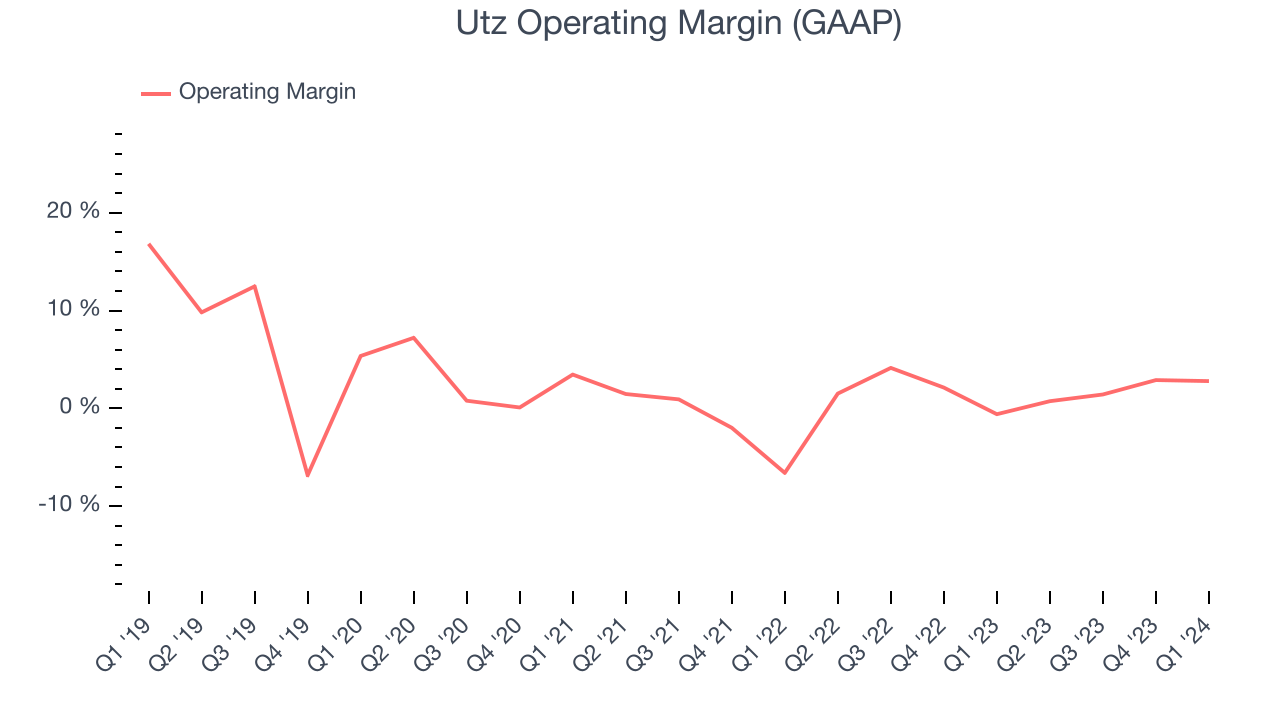 Zooming out, Utz was profitable over the last eight quarters but held back by its large expense base. It's demonstrated subpar profitability for a consumer staples business, producing an average operating margin of 1.9%. Its margin has also seen few fluctuations, meaning it will likely take a big change to improve profitability.
Zooming out, Utz was profitable over the last eight quarters but held back by its large expense base. It's demonstrated subpar profitability for a consumer staples business, producing an average operating margin of 1.9%. Its margin has also seen few fluctuations, meaning it will likely take a big change to improve profitability.EPS
These days, some companies issue new shares like there's no tomorrow. That's why we like to track earnings per share (EPS) because it accounts for shareholder dilution and share buybacks.
In Q1, Utz reported EPS at $0.14, up from $0.11 in the same quarter a year ago. This print beat Wall Street's estimates by 10.5%.
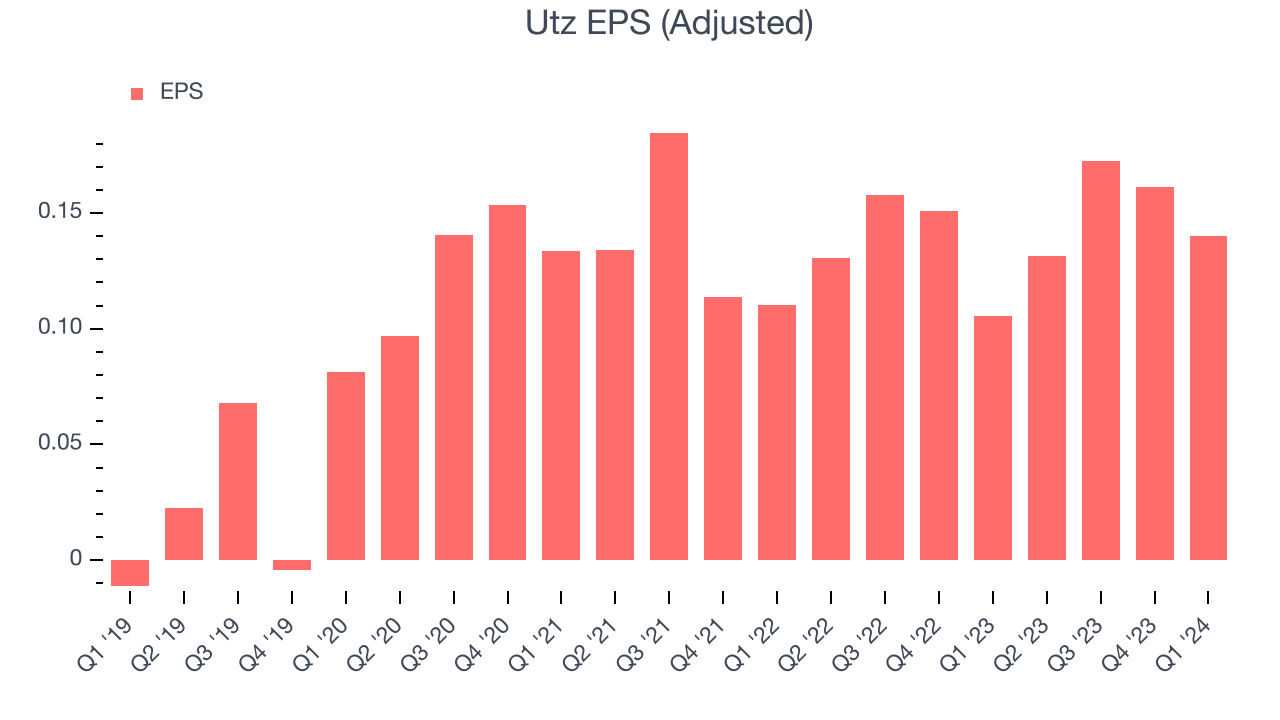
Between FY2021 and FY2024, Utz's EPS grew 15.5%, translating into an unimpressive 4.9% compounded annual growth rate.
On the bright side, Wall Street expects the company to continue growing earnings over the next 12 months, with analysts projecting an average 17.2% year-on-year increase in EPS.
Cash Is King
If you've followed StockStory for a while, you know we emphasize free cash flow. Why, you ask? We believe that in the end, cash is king, and you can't use accounting profits to pay the bills.
Utz burned through $22.7 million of cash in Q1, in line with its cash burn last year. This result represents a negative 6.5% free cash flow margin.
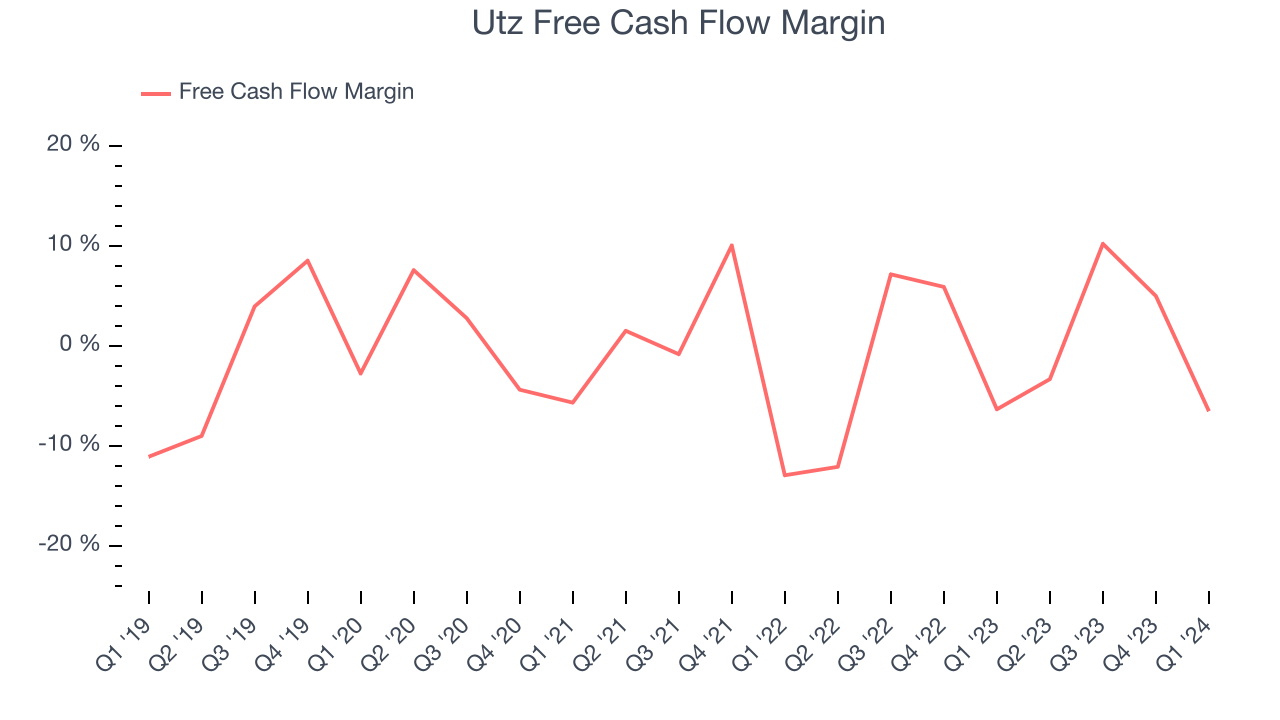
Over the last eight quarters, Utz has shown mediocre cash profitability, putting it in a pinch as it gives the company limited opportunities to reinvest, pay down debt, or return capital to shareholders. Its free cash flow margin has averaged 0.1%, subpar for a consumer staples business. However, its margin has averaged year-on-year increases of 2.7 percentage points over the last 12 months. Continued momentum should improve its cash flow prospects.
Return on Invested Capital (ROIC)
EPS and free cash flow tell us whether a company was profitable while growing revenue. But was it capital-efficient? A company’s ROIC explains this by showing how much operating profit a company makes compared to how much money the business raised (debt and equity).
Utz's five-year average ROIC was 0.9%, somewhat low compared to the best consumer staples companies that consistently pump out 20%+. Its returns suggest it historically did a subpar job investing in profitable business initiatives.
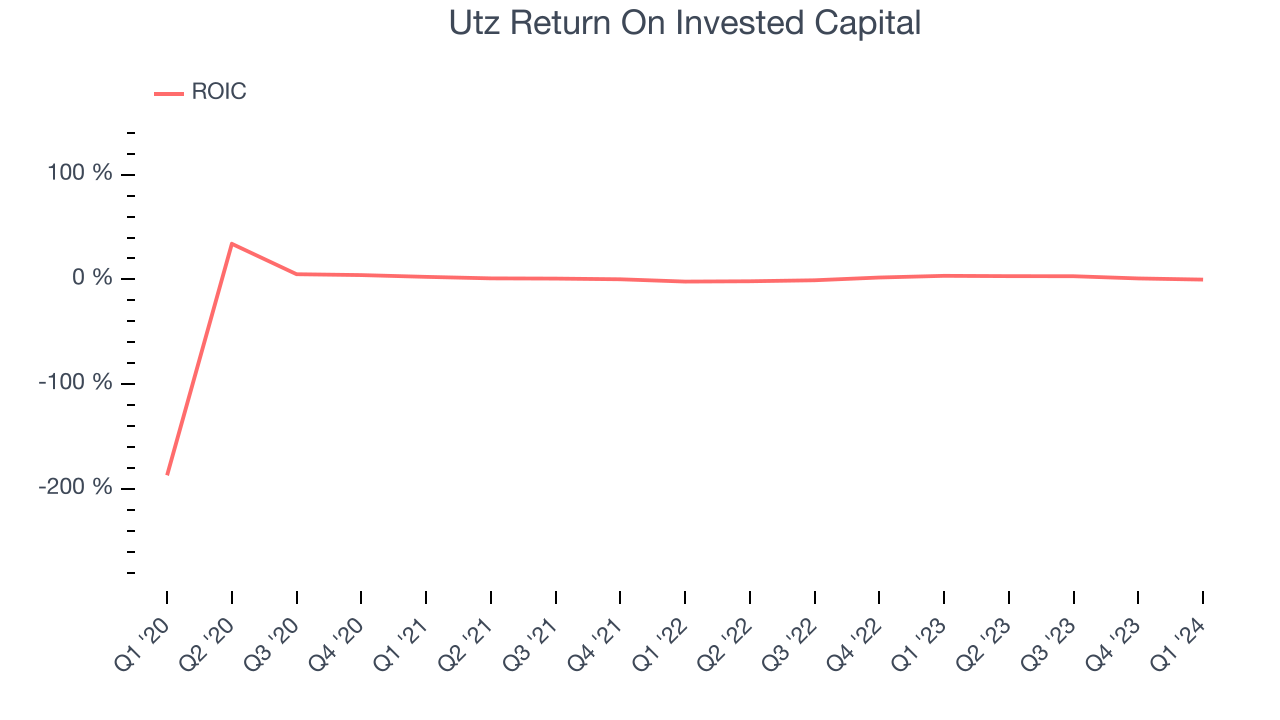
The trend in its ROIC, however, is often what surprises the market and drives the stock price. Over the last few years, Utz's ROIC averaged 1.4 percentage point increases. This is a good sign, and we hope the company can continue improving.
Balance Sheet Risk
As long-term investors, the risk we care most about is the permanent loss of capital. This can happen when a company goes bankrupt or raises money from a disadvantaged position and is separate from short-term stock price volatility, which we are much less bothered by.
Utz reported $47 million of cash and $783.7 million of debt on its balance sheet in the most recent quarter. As investors in high-quality companies, we primarily focus on two things: 1) that a company's debt level isn't too high and 2) that its interest payments are not excessively burdening the business.
With $242.6 million of EBITDA over the last 12 months, we view Utz's 3.0x net-debt-to-EBITDA ratio as safe. We also see its $60.04 million of annual interest expenses as appropriate. The company's profits give it plenty of breathing room, allowing it to continue investing in new initiatives.
Key Takeaways from Utz's Q1 Results
It was good to see Utz beat analysts' adjusted EBITDA and EPS expectations this quarter. On the other hand, its organic revenue unfortunately missed analysts' expectations and its operating margin missed Wall Street's estimates. That the company maintained organic sales and adjusted EBITDA guidance for the full year shows that the company is roughly on track. Overall, this was a mixed quarter for Utz. The stock is flat after reporting and currently trades at $18.13 per share.
Is Now The Time?
Utz may have had a tough quarter, but investors should also consider its valuation and business qualities when assessing the investment opportunity.
We cheer for all companies serving consumers, but in the case of Utz, we'll be cheering from the sidelines. Although its revenue growth has been solid over the last three years, its relatively low ROIC suggests it has struggled to grow profits historically. And while its projected EPS for the next year implies the company will generate shareholder value, the downside is its brand caters to a niche market.
Utz's price-to-earnings ratio based on the next 12 months is 25.6x. While we've no doubt one can find things to like about Utz, we think there are better opportunities elsewhere in the market. We don't see many reasons to get involved at the moment.
Wall Street analysts covering the company had a one-year price target of $20.32 per share right before these results (compared to the current share price of $18.13).
To get the best start with StockStory, check out our most recent stock picks, and then sign up to our earnings alerts by adding companies to your watchlist here. We typically have the quarterly earnings results analyzed within seconds of the data being released, and especially for companies reporting pre-market, this often gives investors the chance to react to the results before the market has fully absorbed the information.
